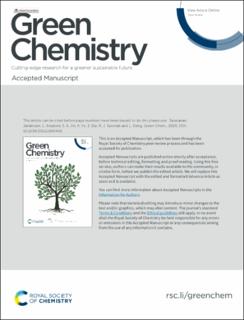| dc.contributor.author | Janakiram, Saravanan | |
| dc.contributor.author | Ansaloni, Luca | |
| dc.contributor.author | Jin, Soo-Ah | |
| dc.contributor.author | Yu, Xinyi | |
| dc.contributor.author | Dai, Zhongde | |
| dc.contributor.author | Spontak, Richard J | |
| dc.contributor.author | Deng, Liyuan | |
| dc.date.accessioned | 2020-05-18T12:49:49Z | |
| dc.date.available | 2020-05-18T12:49:49Z | |
| dc.date.created | 2020-05-06T17:46:47Z | |
| dc.date.issued | 2020 | |
| dc.identifier.issn | 1463-9262 | |
| dc.identifier.uri | https://hdl.handle.net/11250/2654821 | |
| dc.description.abstract | Nanofibrillated cellulose (NFC) represents an important class of bio-based nanomaterials that possess favorable properties including hydrophilicity, 1D structure, biodegradability, and surface tunability. Although widely known for its effective gas-barrier attributes due to its inherent crystallinity and hydrogen-bonding capability, the ability of NFC to form dense films has been of considerable interest in selective gas-separation applications as a viable replacement for synthetic polymers. With precise control of targeted properties at the nanoscale, NFC can likewise be used to enable selective removal of greenhouse gases such as CO2. Herein we report a class of “green” hybrid membranes composed of NFC and an ionic liquid (IL), 1-ethyl-3-methylimidazolium acetate ([Emim][OAc]), that together exhibit exceptional separation properties arising from controllable nanoscopic design. With this new class of green membranes, CO2/N2 selectivities as high as ∼370 and CO2 permeabilities as high as ∼330 Barrer have been obtained at optimal IL loadings and/or humidity levels. The current work demonstrates that size exclusion of a molecular penetrant in a water-swollen NFC membrane matrix relies on the network architecture of partially swollen nanocellulose fibrils to selectively permeate CO2 through enhanced diffusive pathways. Additionally, the gas-transport and rheological properties of these NFC-fabricated membranes can be precisely tuned through the independent use of humidity as an external control parameter. | en_US |
| dc.language.iso | eng | en_US |
| dc.publisher | Royal Society of Chemistry | en_US |
| dc.title | Humidity-responsive Molecular Gate-opening mechanism for Gas Separation in Ultraselective Nanocellulose/IL Hybrid Membranes | en_US |
| dc.type | Peer reviewed | en_US |
| dc.type | Journal article | en_US |
| dc.description.version | acceptedVersion | en_US |
| dc.source.journal | Green Chemistry | en_US |
| dc.identifier.doi | https://doi.org/10.1039/D0GC00544D | |
| dc.identifier.cristin | 1809710 | |
| dc.description.localcode | © 2020. Locked until 6.5.2021 due to copyright restrictions. This is the authors' accepted and refereed manuscript to the article. The final authenticated version is available online at: https://doi.org/10.1039/D0GC00544D | en_US |
| cristin.ispublished | false | |
| cristin.fulltext | postprint | |
| cristin.qualitycode | 1 | |
